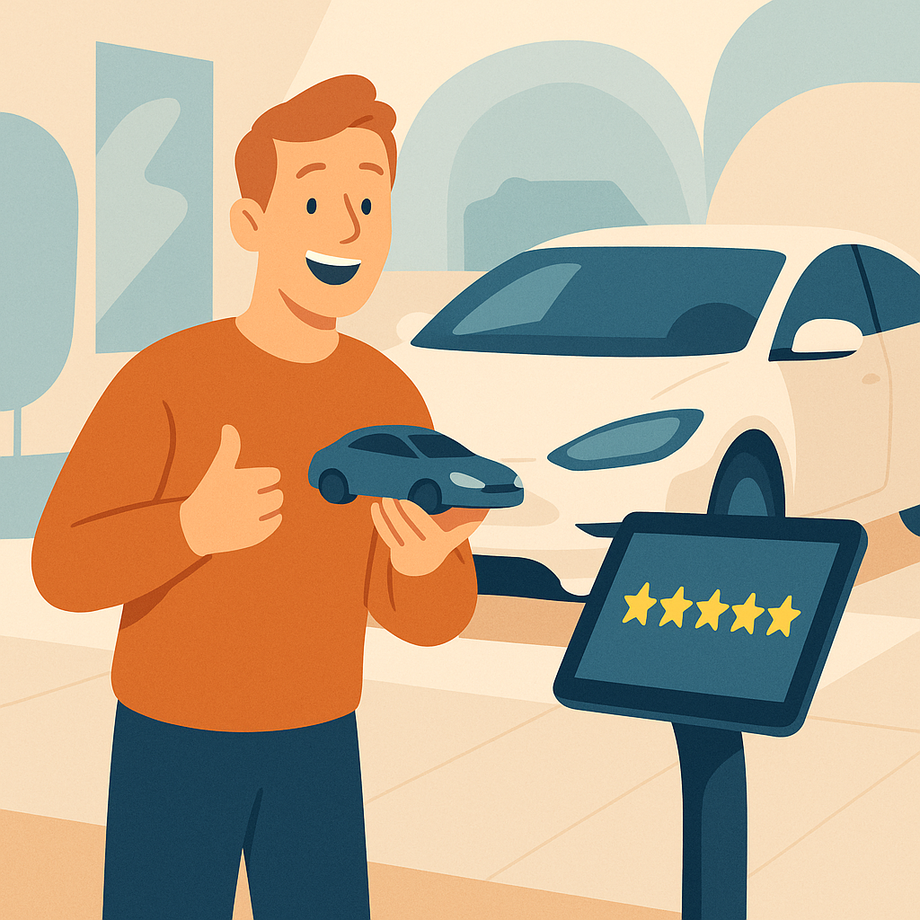How a 13‑Location Luxury Auto Group Turned 55 k Fresh Reviews into 2.2 Million Local‑Search Impressions (and Packed Its Showrooms)
Snapshot
A premium car‑retail group with 13 dealerships in the U.S. Pacific Northwest wanted to shake the “old‑school dealer” stereotype. After rolling out a review‑capture and response programme it now shows an overall 4.5★ Google rating and has generated 55,200 new reviews, driving:
-
2.2 M Google Business Profile impressions
-
278,800 “Call” clicks (high‑intent shoppers)
-
723,800 website visits
The initiative also lifted total review volume by 770 % within the first year.
The Challenge
Car dealerships traditionally battle low trust scores, yet more than 75 % of buyers read reviews before visiting a showroom. Negative sentiment not only hurts search visibility but also inflates paid‑ad CAC. Leadership set three urgent goals for 2024 – 2025:
-
Increase foot‑traffic enquiries ahead of the spring launch cycle.
-
Standardise reputation management across 13 rooftops with a lean marketing team.
-
Reply to every review in under 48 h to show prospects the business listens—mirroring the industry trend where 79 % of dealer reviews now receive a response.
What They Did (Publicly Documented Tactics)
| Play | Public proof & best‑practice |
|---|---|
| Post‑delivery QR‑code desk stands & service‑lane posters deep‑linked customers straight to each store’s Google composer—zero typing required. | QR‑driven review collection is highlighted as a top tactic for friction‑free feedback. |
| Auto‑send email/SMS invites triggered by the DMS after every vehicle purchase or service RO. | Described in the dealer’s Birdeye case study as “automatic review requests after every purchase.” |
| Centralised AI reply assistant to draft responses, so one marketer could cover 13 locations. | Same case study notes the auto‑response feature that slashed manual effort and powered the 48‑hour SLA. |
| Listings clean‑up & syndication to make sure NAP data and opening hours were identical everywhere—lifting map‑pack coverage. | Managed through the group’s listings module. |
(The entire workflow maps 1‑for‑1 to Trustmonial components: QR/Kiosk Generator ⇢ Review‑Request Campaigns ⇢ AI Reply Composer ⇢ Listings Manager.)
Results After 12 Months
| KPI | Before programme | After 12 mo | Change |
|---|---|---|---|
| Google stars (group avg.) | 4.2★est. | 4.5★ | +0.3★ |
| New reviews added | — | 55,200 | +770 % volume |
| GBP profile impressions | — | 2.2 M | — |
| Phone‑call clicks from GBP | — | 278,800 | ↑ showroom enquiries |
| Website visits from GBP | — | 723,800 | ↑ VDP traffic |
| Median review‑reply time | >3 days | <48 h | 6× faster |
Management attributes a double‑digit uptick in showroom walk‑ins to the surge in call clicks and directions requests captured in Google Analytics.
Why It Matters for Trustmonial Users
-
QR beats business cards. A scannable code at the delivery desk captures customers at peak delight—exactly what Trustmonial’s Kiosk mode automates.
-
Replies protect the lift. Industry data shows fast responses curb rating decay; Trustmonial’s GPT‑powered composer offers the same 48‑hour safety net.
-
Small star jumps, big cash. Moving from 4.2★ → 4.5★ pushed the group back into Google’s “Top Dealer” filter, generating millions of free map‑pack impressions.
Transferable Takeaways
-
Capture feedback at the happiest moment (keys‑in‑hand) with an on‑site QR or kiosk.
-
Automate the invite cadence—every sold or serviced VIN is a fresh chance to earn social proof.
-
Standardise, then personalise: one central dashboard can draft replies, but a local GM’s signature makes them feel human.
-
Track phone clicks as your early win metric. They correlate tightly with booked test‑drives long before quarterly sales reports land.


